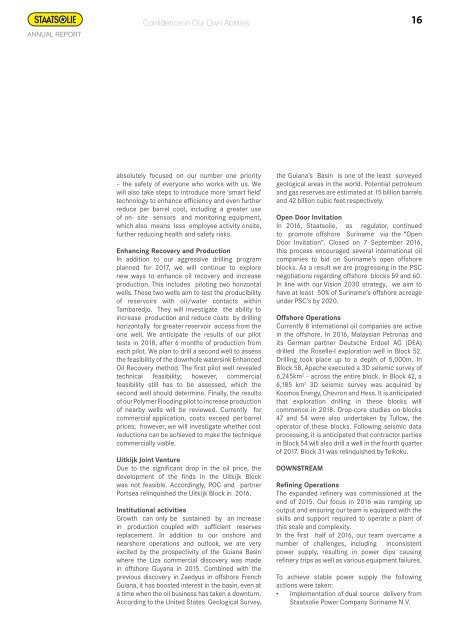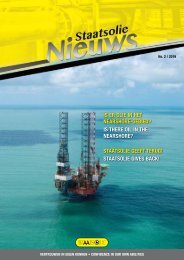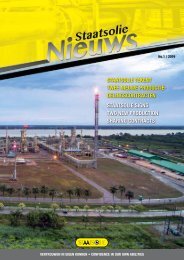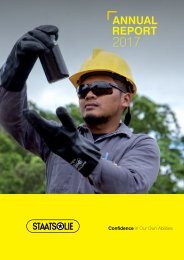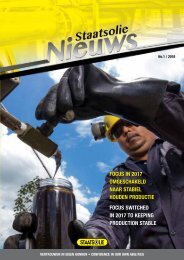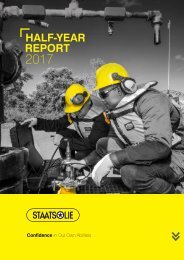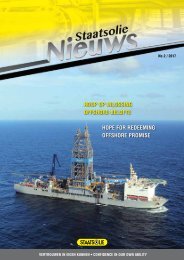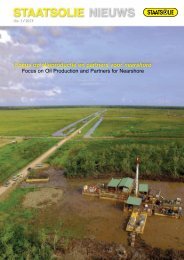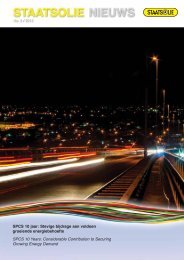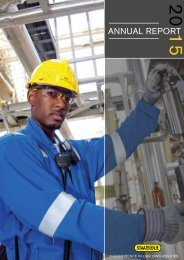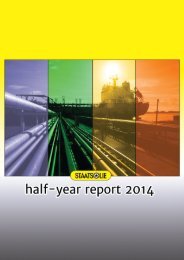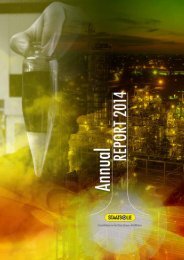annual_repport_staatsolie_2016_lr
You also want an ePaper? Increase the reach of your titles
YUMPU automatically turns print PDFs into web optimized ePapers that Google loves.
Annual REPORT<br />
Confidence in Our Own Abilities<br />
16<br />
absolutely focused on our number one priority<br />
– the safety of everyone who works with us. We<br />
will also take steps to introduce more ‘smart field’<br />
technology to enhance efficiency and even further<br />
reduce per barrel cost, including a greater use<br />
of on‐ site sensors and monitoring equipment,<br />
which also means less employee activity onsite,<br />
further reducing health and safety risks.<br />
Enhancing Recovery and Production<br />
In addition to our aggressive drilling program<br />
planned for 2017, we will continue to explore<br />
new ways to enhance oil recovery and increase<br />
production. This includes piloting two horizontal<br />
wells. These two wells aim to test the producibility<br />
of reservoirs with oil/water contacts within<br />
Tambaredjo. They will investigate the ability to<br />
increase production and reduce costs by drilling<br />
horizontally for greater reservoir access from the<br />
one well. We anticipate the results of our pilot<br />
tests in 2018, after 6 months of production from<br />
each pilot. We plan to drill a second well to assess<br />
the feasibility of the downhole watersink Enhanced<br />
Oil Recovery method. The first pilot well revealed<br />
technical feasibility; however, commercial<br />
feasibility still has to be assessed, which the<br />
second well should determine. Finally, the results<br />
of our Polymer Flooding pilot to increase production<br />
of nearby wells will be reviewed. Currently for<br />
commercial application, costs exceed per barrel<br />
prices; however, we will investigate whether cost<br />
reductions can be achieved to make the technique<br />
commercially viable.<br />
Uitkijk Joint Venture<br />
Due to the significant drop in the oil price, the<br />
development of the finds in the Uitkijk Block<br />
was not feasible. Accordingly, POC and partner<br />
Portsea relinquished the Uitkijk Block in <strong>2016</strong>.<br />
Institutional activities<br />
Growth can only be sustained by an increase<br />
in production coupled with sufficient reserves<br />
replacement. In addition to our onshore and<br />
nearshore operations and outlook, we are very<br />
excited by the prospectivity of the Guiana Basin<br />
where the Liza commercial discovery was made<br />
in offshore Guyana in 2015. Combined with the<br />
previous discovery in Zaedyus in offshore French<br />
Guiana, it has boosted interest in the basin, even at<br />
a time when the oil business has taken a downturn.<br />
According to the United States Geological Survey,<br />
the Guiana’s Basin is one of the least surveyed<br />
geological areas in the world. Potential petroleum<br />
and gas reserves are estimated at 15 billion barrels<br />
and 42 billion cubic feet respectively.<br />
Open Door Invitation<br />
In <strong>2016</strong>, Staatsolie, as regulator, continued<br />
to promote offshore Suriname via the “Open<br />
Door Invitation”. Closed on 7 September <strong>2016</strong>,<br />
this process encouraged several international oil<br />
companies to bid on Suriname’s open offshore<br />
blocks. As a result we are progressing in the PSC<br />
negotiations regarding offshore blocks 59 and 60.<br />
In line with our Vision 2030 strategy, we aim to<br />
have at least 50% of Suriname’s offshore acreage<br />
under PSC’s by 2020.<br />
Offshore Operations<br />
Currently 8 international oil companies are active<br />
in the offshore. In <strong>2016</strong>, Malaysian Petronas and<br />
its German partner Deutsche Erdoel AG (DEA)<br />
drilled the Roselle‐I exploration well in Block 52.<br />
Drilling took place up to a depth of 5,000m. In<br />
Block 58, Apache executed a 3D seismic survey of<br />
6,245km 2 ‐ across the entire block. In Block 42, a<br />
6,185 km 2 3D seismic survey was acquired by<br />
Kosmos Energy, Chevron and Hess. It is anticipated<br />
that exploration drilling in these blocks will<br />
commence in 2018. Drop‐core studies on blocks<br />
47 and 54 were also undertaken by Tullow, the<br />
operator of these blocks. Following seismic data<br />
processing, it is anticipated that contractor parties<br />
in Block 54 will also drill a well in the fourth quarter<br />
of 2017. Block 31 was relinquished by Teikoku.<br />
Downstream<br />
Refining Operations<br />
The expanded refinery was commissioned at the<br />
end of 2015. Our focus in <strong>2016</strong> was ramping up<br />
output and ensuring our team is equipped with the<br />
skills and support required to operate a plant of<br />
this scale and complexity.<br />
In the first half of <strong>2016</strong>, our team overcame a<br />
number of challenges, including inconsistent<br />
power supply, resulting in power dips causing<br />
refinery trips as well as various equipment failures.<br />
To achieve stable power supply the following<br />
actions were taken:<br />
• Implementation of dual source delivery from<br />
Staatsolie Power Company Suriname N.V.


